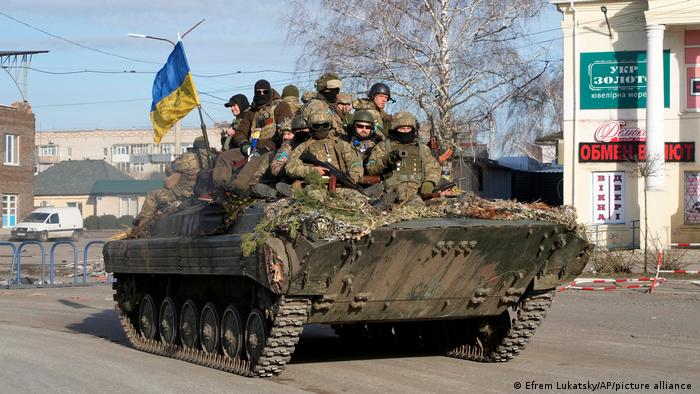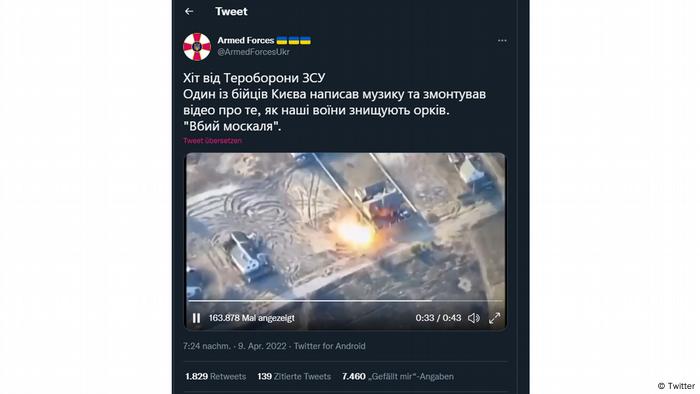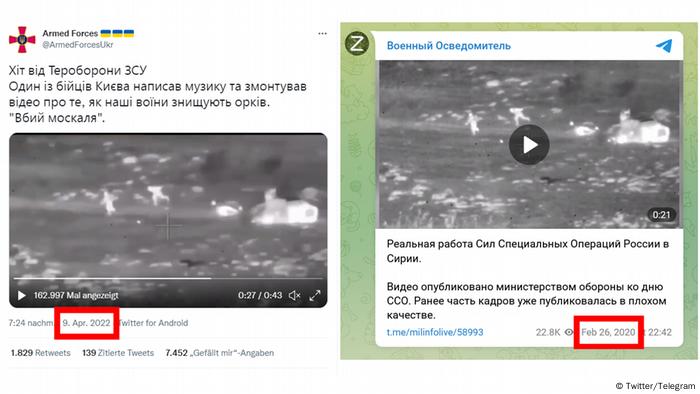Fact check: How to spot a fake military success story in Russia-Ukraine war
Russia's invasion of Ukraine has prompted viral videos claiming military success on both sides. But can you trust the images of drone strikes, snipers and ambushes? DW unpacked one video in search of the truth.

The Ukranian army surprised many experts by resisting against superior Russian units -
but not every success is in fact real
In wartime, supporters of one side or another share "military success" videos of combat footage, often set to music. Besides the moral and ethical issues of spreading such explicitly violent content, there is another problem: Often such videos show military footage from completely different conflicts. This DW fact check examines one example from the ongoing Russia-Ukraine war to see how it stands up to the claims made by the account that posted it. We will also share the methods and tools we used to verify the footage used.

Claim: An unofficial Twitter page supporting the armed forces of Ukraine (@ArmedForcesUkr) with more than 450,000 followers describes its 42-second clip as containing "a hit song of the Territorial Defense of the Ukrainian Armed Forces." They use the derogatory term "orcs" to describe Russian soldiers. The video contains 16 separate scenes of explosions, death and destruction, mostly carried out by drone strikes but also roadside bombs and sniper attacks.
The editing is matched to cheerful music with a child's voice singing "La la la, kill the Moskal," which is an ethnic slur against Russians.
But does it really contain successes of the Ukrainian army?
Verdict: Misleading
DW has tried to identify the 16 sources used in the clip and found that six are definitely not from the 2022 Russia-Ukraine war. In fact, one scene of alleged Ukrainian military prowess actually shows Russian snipers at work. The remaining 10 incidents might be legitimate but cannot be 100% verified.
Beware of 'official' films posted from unofficial accounts
The user @ArmedForcesUkr does not have an official Twitter verification tick, which might account for the misleading nature of the clip. The video's first and the last scenes first appeared on digital platforms in October 2020, during the war between Azerbaijan and Armenia. At least one scene can be traced back to official Azeri military footage of attacks by Bayraktar drones, which are also used by Ukraine against Russian forces.
The footage is cropped and has lost a great deal of clarity, either because it has been shared so often or because the filmmaker wanted to hide its origin.

What is allegedly current footage (left) was published more than two years ago (right)
The night-vision footage at 26 seconds was probably first posted in February 2020 by a Russian account "milinfolive" on social media platforms like VKontakte and Telegram. That post describes the footage as the work of Russian Special Forces in Syria. According to the account, the footage was published by the Defense Ministry (see screenshot).
It is the only footage in the video that shows images of people being shot at close range, rather than targeted by drone missiles.
More than one third of the film's content is false
Just 27 seconds of the 42-second clip can be sourced to video that appeared on digital platforms only after the Russian invasion of Ukraine in February 2022. Some of it is watermarked @polkazov and can be traced to the media operation of Ukraine's Azov battalion. These clips claim to show Ukraine attacks in the besieged city of Mariupol in mid-March 2022.
Some footage appears to have been sourced from a Ukraine Armed Forces compilation of drone strikes near Kherson from March 18, 2022, posted on YouTube. Another scene apparently showing an anti-tank missile strike was posted to Telegram on March 27, 2022 by a member of Ukraine's National Security, Defense and Intelligence Committee, Yuriy Misyagin.
Tracking down the original videos
DW verified the material in the @ArmedForcesUkr post using reverse image searching of screenshots of each scene to locate the video uploads. We then compared the first appearances of the videos in question to determine whether they pre-dated the 2022 Russian invasion of Ukraine. There are several useful sites for this task such as TinEye and Yandex Visual Search, as well as browser plug-ins such as RevEye.
In viral videos, visual power often triumphs over truth
In the case of the video from @ArmedForcesUkr, many Twitter users immediately commented that the clip contained non-Ukrainian footage. Nevertheless, the video has at the time of writing been viewed more than 160,000 times, with the majority of users celebrating its content
No comments:
Post a Comment